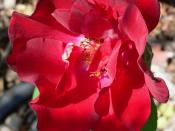Pearl's Force of Nature The force of nature is powerful and cannot be escaped or denied. It is everywhere, and it is often used to symbolize many different ideas, such as birth, freedom, and change. The idea of nature as an important symbol is prominent in Nathaniel Hawthorne's The Scarlet Letter. In the novel, Hester Prynne is marred with the red letter A, for adulteress, on her breast for all of her life. A result of her sin, was the birth of her daughter, Pearl. Pearl is often thought to be a demonic and evil child, but in reality she is extremely observant, sweet and perceptive. Pearl shows her feelings and personality through elements of the natural world. Pearl is shown as a force of nature because she connects to her mother through it, she is the product of a wild and passionate union and she is happiest outside the bounds of the city.
.
The first way Pearl is seen in nature is through her connection to her mother. Pearl has a rather odd, but very noticeable way of connecting to her mother. She uses nature to show her query and also her understanding of her mother's sin and its consequences. There are numerous examples of these connections between Pearl and Hester. Pearl began this connection through nature when she was very young. "In an afternoon of a certain summer's day, after Pearl grew big enough to run about, she amused herself with gathering handfuls of wild-flowers, and flinging them, one by one, at her mother's bosom; dancing up and down" (67). Even at a young age, Pearl knew that she was somehow involved with the scarlet A on her mother's dress, and she made this connection through the natural world. Another example is when Pearl, "taking a handful of these [prickly burrs]...arranged them along the lines of the scarlet letter that decorated the maternal bosom, to which the line of burrs, as their nature was, tenaciously adhered. Hester did not pluck them off" (92). This action that Pearl made is very symbolic in many ways. One such way is Pearl's use of prickly burrs (a part of nature) to outline the A. Also important, is the fact that Hester did not remove the burrs, showing her recognition of Pearl's knowledge and understanding. Another symbol is the way the burrs (a part of nature) stuck to the A and did not come off, representing Pearl as a part of her mother and of the A that she can never deny. Another way that Pearl connects to her mother through nature, not directly involving Hester's A, is the fact that she has a natural skill of adorning herself and others with natural elements, like her mother's talent of sewing (141). Pearl did not always know how to show her understanding of her mother's scarlet letter, but whenever she did show it, it was expressed through nature.
Secondly, Pearl was a product of a wild, free union and could easily relate to nature. Pearl was the outcome of a natural relationship and juncture. "In her was the tie that united them [Hester and Dimmesdale]. She had been offered to the world....as the living hieroglyphic , in which was revealed the secret they so darkly sought to hide-all written in this symbol-all plainly manifest....." (141). Pearl truly was a part of nature. Also, Pearl had a strong relationship with elements not of worldly or material objects, especially the babbling brook of the forest. "Pearl resembled the brook , inasmuch as the current of her life gushed from a well-spring as mysterious, and had flowed through scenes as shadowed as heavily with gloom" (128). Just as the brook's origins are unknown, and its course is uncontrollable, so is Pearl. This close relationship with the natural world shows her as a strong force of nature. "The truth seems to be, however, that the mother-forest, and these wild things which it nourished, all recognized a kindred wildness in the human child. (140). Pearl could affiliate with things of the wilderness, and this relationship was both comforting and welcoming.
The last way Pearl is viewed as a force of nature is the fact that she is happiest there and has no need for interaction with her peers. For example, one day in the forest, "Pearl gathered the violets, and anemones, and columbines and some twigs of the freshest green....[and] with these she decorated her hair, and her young waist..." (141). Pearl was not interested in dolls or toys; she found her joy and merriment in playing with things of the natural world. She had a longing to "play" with nature and accept it as her faithful companion. For instance, "Pearl...imperatively required that the whole breadth of sunshine should be stripped off its [the house's] front, and given her to play with" (71). Here, Pearl desired to engage in childish play with an element of the natural world, the sunlight, and was saddened to find out that she could not. Pearl enjoyed being in the presence of nature, and she would much rather spend time there, than with her young peers. The children of the town did not accept Pearl and were often mean to her and Hester. An example of this behavior is when Pearl and Hester are walking in the town and a young child says, "Behold, verily, there is the woman of the scarlet letter; and, of a truth, moreover, there is the likeness of the scarlet letter running along by her side! Come, there fore, and let us fling mud at them!" (70). The children of the town were not kind to Pearl at all, and when she heard their talk, she "...after frowning, stamping her foot, and shaking her little hand with a variety of threatening gestures, suddenly made a rush at the knot of her enemies, and put them all to flight" (70). Pearl did not wish to be in the company of her peers, but rather to be surrounded by the wilderness. The natural world comforted Pearl and "became the playmate of the lonely infant, as well as it knew how. Sombre as it was, it [nature] put on the kindest of its moods to welcome her [Pearl]...and she was gentler here than in the grassy-margined streets of the settlement, or in her mother's cottage"" (140). Nature soothed Pearl in times of loneliness and she was happiest when in its presence.
Pearl's relationship with the natural world was her link to her mother, her way of understanding, and was her source of happiness and joy. Pearl's connection with the wilderness was very powerful, and this connection made Pearl a stronger and better person. In this novel, Pearl is viewed as a child of the wild and free world, who greatly enjoys being there. She shows the reader what a powerful element nature is, and how it can change someone's entire world.





